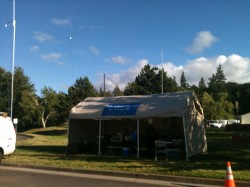 I passed my technician exam and became a HAM nine years ago while attending Cal Poly. A number of us were involved with the Cal Poly Picosatellite Project, which involved designing an orbital satellite capable of down-linking remote sensor data via HAM radio bands. Many of the engineers on the project became HAMs in order to communicate with this and other orbital satellites carrying amateur radio (OSCARs). Unfortunately, I ended up graduating before I could use the privileges my new license provided, and I haven’t been involved in amateur radio since then. That is, until a few months ago, when the local LDS church put on an emergency preparedness fair. Several classes were offered at the fair, including one that covered the importance of amateur radio in emergencies. This was all that was necessary to rekindle my interest in this hobby and begin preparing to upgrade my license to a general class. With my new found motivation I realized that I had still never been on the air, a fact I was somewhat embarrassed to admit to other HAMs. I decided to attend our local field day where I learned that my situation wasn’t uncommon. I also had the opportunity, after nine years, to get on the air and make distant contacts.
I passed my technician exam and became a HAM nine years ago while attending Cal Poly. A number of us were involved with the Cal Poly Picosatellite Project, which involved designing an orbital satellite capable of down-linking remote sensor data via HAM radio bands. Many of the engineers on the project became HAMs in order to communicate with this and other orbital satellites carrying amateur radio (OSCARs). Unfortunately, I ended up graduating before I could use the privileges my new license provided, and I haven’t been involved in amateur radio since then. That is, until a few months ago, when the local LDS church put on an emergency preparedness fair. Several classes were offered at the fair, including one that covered the importance of amateur radio in emergencies. This was all that was necessary to rekindle my interest in this hobby and begin preparing to upgrade my license to a general class. With my new found motivation I realized that I had still never been on the air, a fact I was somewhat embarrassed to admit to other HAMs. I decided to attend our local field day where I learned that my situation wasn’t uncommon. I also had the opportunity, after nine years, to get on the air and make distant contacts.
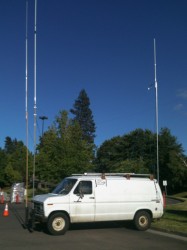 Field day is an exercise organized by the Amateur Radio Relay League (ARRL), held annually on the fourth weekend in June. It is considered the largest emergency preparedness exercise in North America, with over thirty thousand operators participating across all of the amateur radio bands. Field day starts on Friday when HAMs gather at a predetermined outdoor location to set up an emergency communications center (typically a tent), radio gear, antennas, power supplies and amenities (such as heaters, food, coolers, etc.). The exercise begins at 1800 UTC on Saturday and ends at 2059 UTC on Sunday, after which the HAMs pack up their gear and head home. During the exercise the objective is to make as many contacts as possible under field conditions. In addition to being an emergency communications exercise, it is also a contest, with points being awarded for each contact made. More points are awarded for distant contacts or for using lower power levels to transmit. Contacts can be made with voice communication or by utilizing digital radio modes and Morse code (CW). According to the ARRL web page, the objective of field day is:
Field day is an exercise organized by the Amateur Radio Relay League (ARRL), held annually on the fourth weekend in June. It is considered the largest emergency preparedness exercise in North America, with over thirty thousand operators participating across all of the amateur radio bands. Field day starts on Friday when HAMs gather at a predetermined outdoor location to set up an emergency communications center (typically a tent), radio gear, antennas, power supplies and amenities (such as heaters, food, coolers, etc.). The exercise begins at 1800 UTC on Saturday and ends at 2059 UTC on Sunday, after which the HAMs pack up their gear and head home. During the exercise the objective is to make as many contacts as possible under field conditions. In addition to being an emergency communications exercise, it is also a contest, with points being awarded for each contact made. More points are awarded for distant contacts or for using lower power levels to transmit. Contacts can be made with voice communication or by utilizing digital radio modes and Morse code (CW). According to the ARRL web page, the objective of field day is:
To work as many stations as possible on any and all amateur bands (excluding the 60, 30, 17, and 12-meter bands) and to learn to operate in abnormal situations in less than optimal conditions. Field Day is open to all amateurs in the areas covered by the ARRL/RAC Field Organizations and countries within IARU Region 2. DX stations residing in other regions may be contacted for credit, but are not eligible to submit entries.
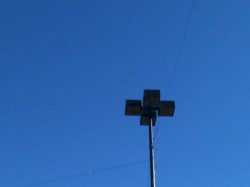
At 6PM on Friday the Radio Amateurs of the Gorge arrived at our local Walmart’s parking lot and proceeded to set up their tent and radio gear. The fire department also attended with an engine featuring a bucket and hydraulic lift. They used it to assist the HAMs in placing a 40 meter and 80 meter antenna between two parking lot lamp posts. Often, the fire and police departments coordinate with amateur radio operators during a widespread disaster, so this was also considered practice for the fire department.
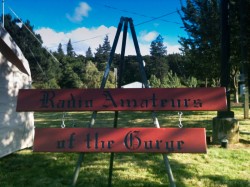 I arrived at the event at 6PM local time on Saturday. The sun was beginning to set, promising greater range due to the reflective characteristics of the ionosphere during the night. Our station featured four transceivers, primarily working the 20, 40 and 80 meters bands with voice and CW. I watched the HAMs work these four stations and it wasn’t long before I was in the operator seat, announcing my call, hoping for a response. I made my first contact on 40 meters working the station WV7I out of Boise, Idaho. He came in loud and clear and we were able to exchange information quickly. The contact ended with a thank you on his end and loud cheering on my end. The other HAMs in our tent were happy to see me finally make a contact and probably recalled how exciting the hobby was when they first started it. I soon switched to working 80 meters and proceeded to make three additional contacts:
I arrived at the event at 6PM local time on Saturday. The sun was beginning to set, promising greater range due to the reflective characteristics of the ionosphere during the night. Our station featured four transceivers, primarily working the 20, 40 and 80 meters bands with voice and CW. I watched the HAMs work these four stations and it wasn’t long before I was in the operator seat, announcing my call, hoping for a response. I made my first contact on 40 meters working the station WV7I out of Boise, Idaho. He came in loud and clear and we were able to exchange information quickly. The contact ended with a thank you on his end and loud cheering on my end. The other HAMs in our tent were happy to see me finally make a contact and probably recalled how exciting the hobby was when they first started it. I soon switched to working 80 meters and proceeded to make three additional contacts:
- N7BI – three alpha out of Western Washington
- K7LEd – six alpha out of Western Washington
- K7LE – two alpha out of Oregon
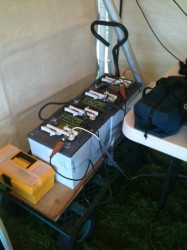
As a new operator, it makes sense that my contacts were mostly local. To successfully make a contact, an operator must exchange a call sign, section (geographic) information and station information, including the number of transmitters and power source. Distant signals are very close to the noise floor and become very difficult to understand. On top of this, when a station announces “CQ CQ field day”, a minimum of 5 other stations immediately announce their call, causing a pile-up. The original station will often pick the clearest signal to respond to, forcing the others to wait their turn. In many cases we were the weakest signal since we were only transmitting with 100 Watts, much less than the maximum 1500 Watts allowed. The other operators were successful in making contacts as far east as Michigan, as far south as San Diego and as far west as Hawaii. We even heard some stations from Asia, but they were broadcast stations not participating in Field Day.
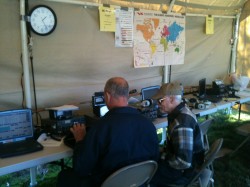 Information exchange uses the NATO phonetic alphabet, where distinct words are associated with a letter of the alphabet. The phonetic alphabet is widely utilized in radio communication for military, aviation and amateur radio since it is easier to pick out distinct words in a radio channel that is polluted with static and experiencing periodic fading due to atmospheric effects. I was surprised that many HAMs used their own words. Zanzibar instead of Zulu, Mexico instead of Mike and Radio instead of Romeo, just to name a few. In each case the receiver would repeat the station’s call using their version of the phonetic alphabet. I stuck to the NATO alphabet since that is what I learned during flight school.
Information exchange uses the NATO phonetic alphabet, where distinct words are associated with a letter of the alphabet. The phonetic alphabet is widely utilized in radio communication for military, aviation and amateur radio since it is easier to pick out distinct words in a radio channel that is polluted with static and experiencing periodic fading due to atmospheric effects. I was surprised that many HAMs used their own words. Zanzibar instead of Zulu, Mexico instead of Mike and Radio instead of Romeo, just to name a few. In each case the receiver would repeat the station’s call using their version of the phonetic alphabet. I stuck to the NATO alphabet since that is what I learned during flight school.
 I worked stations from 6PM local time until the early hours of the morning. The atmosphere inside our field communications center resembled that of the LAN parties I attend while in college. We were a bunch of technically-inclined guys geeking out, surrounded by high-end electronics and subsisting on caffeine and sugar. When not speaking on the radio, we engaged each other in conversion on topics including nanotechnology, robotics, software, electronics, astronomy, aviation and, of course, radio. At one point the subject of HAM radio came up with respect to the burden it places on many marriages. I explained that a similar burden is placed on marriages when one one spouse is a pilot, so I shared my concern that I am both a pilot and a HAM. They said that I was “screwed”, but I offered that my strategy was to involve my wife in my hobbies. A member of our group then lamented that his wife would never put in the effort to pass the technician exam, a sentiment immediately recognized by the others. I had a feeling that mine would, so I sent her a text message asking if she would get her HAM license, to which she replied “Sure! What does that involve?”. I am so blessed!
I worked stations from 6PM local time until the early hours of the morning. The atmosphere inside our field communications center resembled that of the LAN parties I attend while in college. We were a bunch of technically-inclined guys geeking out, surrounded by high-end electronics and subsisting on caffeine and sugar. When not speaking on the radio, we engaged each other in conversion on topics including nanotechnology, robotics, software, electronics, astronomy, aviation and, of course, radio. At one point the subject of HAM radio came up with respect to the burden it places on many marriages. I explained that a similar burden is placed on marriages when one one spouse is a pilot, so I shared my concern that I am both a pilot and a HAM. They said that I was “screwed”, but I offered that my strategy was to involve my wife in my hobbies. A member of our group then lamented that his wife would never put in the effort to pass the technician exam, a sentiment immediately recognized by the others. I had a feeling that mine would, so I sent her a text message asking if she would get her HAM license, to which she replied “Sure! What does that involve?”. I am so blessed!

